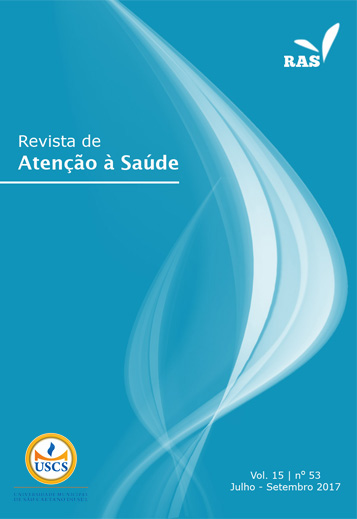NURSING CARE PROVIDED TO WOMEN ON HEMODIALYSIS IN A HOSPITAL OF TRIÂNGULO MINEIRO
DOI:
https://doi.org/10.13037/ras.vol15n53.4582Keywords:
Nursing education, hemodialysis hospital units, quality of lifeAbstract
Introduction: Hemodialysis corresponds to a rigorous and continuous treatment, which brings physical and psychological limitations to patients. This way, nursing care becomes indispensable for coping with the difficulties found and adhesion to treatment. Objectives: This study aims to analyze the quality of nursing care provided to women on hemodialysis. Materials and methods: This is a descriptive, cross-sectional field research with a qualitative approach, that it was done in the hemodialysis sector of a University Hospital of Triângulo Mineiro/MG. Results: Analyzing the answers, it was possible to observe that the majority of women classified the nursing care and the information provided to them as satisfactory for their treatment. Conclusion: This way, nursing care is directed not only to avoid the complications that may be present during the hemodialysis sessions, but also to cope with the anxieties and consequent acceptance of the disease and adhesion to treatment, as well as clarification of the doubts of the patients and their relatives.
Downloads
References
Bastos MG, Bregman R, Kirsztajn GM. Doença renal crônica: frequente e grave, mas também prevenível e tratável. Rev Assoc Med Bras. 2009;56(2):248-53.
Santana SS, Fontenelle T, Magalhães LM. Assistência de enfermagem prestada aos pacientes em tratamento hemodialítico nas unidades de nefrologia. Rev Científica do ITPAC. 2013;6(3):1-11.
Cabral AS. O que é hemodiálise? [Internet]. São Paulo: Sociedade Brasileira de Nefrologia. 2017 [citado em 2015 mar 28]. Disponível em: https://goo.gl/wtmfK7
Castro, MCM. Atualização em diálise: Complicações agudas em hemodiálise. J Bras Nefrol. 2001;23(2):108-13.
Crestani Filho VJ, Rodrigues RAC. Progression of chronic kidney disease: ambulatory experience in Santarém - Pará. J Bras Nefrol [Internet]. 2013 [citado em 2016 mar 17];35(2):99-106. Disponível em: https://goo.gl/EMkhPX
Cabral AS. Carta da nefrologia [Internet]. São Paulo: Sociedade Brasileira de Nefrologia. 2017 [citado 2017 jul 02]. Disponível em: https://sbn.org.br/carta-da-nefrologia/
Santos I, Rocha RPF, Berardinelli LMM. Necessidades de orientação de enfermagem para o autocuidado de clientes em terapia de hemodiálise. Rev Bras Enferm. 2011;64(2):335-42.
Guedes KD, Guedes HM. Qualidade de vida do paciente portador de insuficiência renal crônica. Rev Ciênc Saúde. 2012;5(1):48-53.
Takemoto AY, Okubo P, Bedendo J, Carreira L. Avaliação da qualidade de vida em idosos submetidos ao tratamento hemodialítico. Rev Gaucha Enferm. 2011;32(2):256-62.
Soares KTA, Viesser MV, Rzniski TAB, Brum EP. Eficácia de um protocolo de exercícios físicos em pacientes com insuficiência renal crônica, durante o tratamento de hemodiálise, avaliada pelo SF-36. Fisioter Mov. 2011;24(1):133-40.
Reis CK, Guirardello EB, Campos CJG. O indivíduo renal crônico e as demandas de atenção. Rev Bras Enferm. 2008;61(3):336-41.
Santos TMB, Frazão IS. Qualidade de vida dos trabalhadores que realizam hemodiálise. Rev Ciênc Méd. 2012;21(1-6):5-14.
Silva AS, Silveira RS, Fernandes GFM, Lunardi VL, Backes VMS. Percepções e mudanças na qualidade de vida de pacientes submetidos à hemodiálise. Rev Bras Enferm. 2011;64(5):839-44.
Terra FS, Costa AMDD. Avaliação da qualidade de vida de pacientes renais crônicos submetidos à hemodiálise. Rev Enferm UERJ. 2007;15(3):430-36.
Valcanti CC, Chaves ECL, Mesquita AC, Nogueira DA, Carvalho EC. Religious/spiritual coping in people with chronic kidney disease undergoing hemodialysis. Rev Esc Enferm USP. 2012;46(8):838-45.
Erbs GC, Nerbass FB, Silva RMG, Luz Filho HA, Vieira MA. A influência da escolaridade na qualidade de vida de pacientes em diálise [Internet]. Joinville: Fundação Pró Rim. 2011 [citado em 2017 set 22]. Disponível em: https://goo.gl/5RQfbr
Pessuto J, Carvalho EC. Fatores de risco em indivíduos com hipertensão arterial. Rev Lat Am Enfermagem. 1998;6(1):33-9.
Moura RMF, Silva FCR, Ribeiro GM, Sousa LA. Efeitos do exercício físico durante a hemodiálise em indiví¬duos com insuficiência renal crônica: uma revisão. Fisioter Pesqui. 2008;15(1):86-91.
Paula RB, Fernandes NC, Carmo VMP, Andrade LCF, Bastos MG. Obesidade e doença renal crônica. J Bras Nefrol. 2006;28(3):158-64.
Menezes WN. Cidadania feminina: um longo e tortuoso caminho. Emancipação. 2005;5(1):53-69.
Cesarino CB, Borges PP, Ribeiro RCHM, Ribeiro DF, Kusumota L. Avaliação do risco cardiovascular de pacientes renais crônicos segundo critérios de Framingham. Acta Paul Enferm. 2013;26(1):101-7.
Silva AS, Silveira RS, Fernandes GFM, Lunardi VL, Backes VMS. Percepções e mudanças na qualidade de vida de pacientes submetidos à hemodiálise. Rev Bras Enferm. 2011;64(5):839-44.
Nascimento CD, Marques IR. Intervenções de enfermagem nas complicações mais frequentes durante a sessão de hemodiálise: revisão da literatura. Rev Bras Enferm. 2005;58(6):719-22.
Gullo ABM, Lima AFC, Silva MJP. Reflexões sobre comunicação na assistência de enfermagem ao paciente renal crônico. Rev Esc Enferm USP. 2000;34(2):209-12.
Downloads
Published
Issue
Section
License
Policy Proposal for Journals offering Free Delayed Access
Authors who publish in this magazine agree to the following terms:
- Authors maintain the copyright and grant the journal the right to the first publication, with the work simultaneously licensed under a Creative Commons Attribution License after publication, allowing the sharing of the work with recognition of the authorship of the work and initial publication in this journal.
- Authors are authorized to assume additional contracts separately, for non-exclusive distribution of the version of the work published in this magazine (eg, publishing in institutional repository or as a book chapter), with the acknowledgment of the authorship and initial publication in this journal.
- Authors are allowed and encouraged to publish and distribute their work online (eg in institutional repositories or on their personal page) at any point before or during the editorial process, as this can generate productive changes, as well as increase impact and citation of the published work (See The Effect of Open Access).









